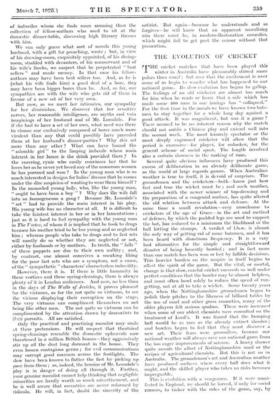THE EVOLUTION OF CRICKET
THE cricket matches that have been played this winter in Australia have pleasurably stirred more pulses than usual ; but now that the excitement is over some of us begin to wonder what has happened to our national game. Its slow evolution has begun to gallop. The feelings of an old cricketer are almost too much for him when he reads or hears that a side which has made some 400 runs in one innings has ". collapsed." For the first time in the annals we have known two bats- men to stay together for a whole long day against a good attack. It was magnificent, but was it a game? There seemed to be no inherent reason why the match should not outdo a Chinese play and extend well into the second week. The most leisurely spectator or the most deeply engrossed cricketer will allow that the period is excessive—for player, for onlooker, for the general scheme of social sport. The length involved also a certain slowness in the making of runs.
Several quite obvious influences have produced this excess of deliberation in an already deliberate game, as the world at large regards games. When .Australian weather is true to itself, it is devoid of surprises. The groundsmen and the cricketers—both—know just how fast and true the wicket must be ; and such weather, associated with the newer science of top-dressing and the preparation of a congenial surface, has quite altered the old relation between attack and defence. At the same time a small revolution—very unwelcome to cricketers of the age of Grace—in the art and method of defence, by which the padded legs are used to support the bat, has reduced to a minimum the likelihood of the ball hitting the stumps. A verdict of I.b.w. is almost the only way of getting rid of some batsmen, and it has been heard with disastrous frequency. It is a very bad alternative for the simple and .straightforward disaster of being honestly bowled ; and in . fact more than one match has been won or lost by fallible decisions. This heavier burden on the umpire in itself begins to affect the spirit of the game. But the vital, or mortal, change is that slow, careful cricket succeeds so well under perfect conditions that the bowler may be almost helpless, and must often bowl solely to reduce the speed of run- getting, not at all to take a wicket. Some twenty years ago, when the Nottinghamshire groundsmen began to polish their pitches to the likeness of billiard tables by the use of marl and other grass cosmetics, many of the older players felt serious qualms. These were increased when some of our ablest chemists were consulted on the treatment of Lord's. It was feared that the bumping ball would be as rare as the already extinct shooter ; and bowlers began to feel that they must discover a new art. Their fears were groundless, because our national weather will always save our national game from the too eager improvements of science. A heavy shower quite ,annuls the effect of Nottinghamshire marl or the recipes of agricultural chemists. But this is not so in Australia. The groundsman's art and Australian weather have produced surfaces where every ball -does what it ought, and the skilled player who takes no risks becomes impregnable.
This is evolution with a vengeance. If it were mani- fested in England, we should be forced, if only for social reasons, to tinker with the rules of the game, say, by reducing the breadth of the hat (which is much the best of many suggested reforms). But Australians accept what they now call " Marathon matches " as an added attraction rather than a drawback. They enjoy the lengthiness and rejoice in every new " best-on-record." Those of us who have travelled over that level land know why. It is a country where life is easy and leisurely, and hurry is eliminated. It is a country where games of all sorts flourish as nowhere else in the world. One of the first acts in the establishment of a New South Wales settlement of smallholders, visited by the writer, was the making of a dozen hard tennis courts ; and the work needed little more than the shaving of the surface. In such a country the expenditure of a week's interest on a single match has none of the portentous significance it would have in any country of the Old World. The conclusion is that, in spite of fears, the latest advance in the development of the game will be accepted. The Australians have the leisure that suits their continuous suns. We who are busier with more crowded pro- grammes have a clime that for the most part keeps the game within prescribed limits. We each accept the other's conditions, but only cricketers and those who have had experience of both countries know how very different in technique is the Australian and the English game. Cricket evolution in the Island Continent has brought not only new methods but a new mood. Bowlers need a new variety of spin, batsmen a new sort of patience, captains may practise strategy as well as tactics. And since in general the more perfect the condition the higher the art, Australia will always be very hard to defeat.
It is possible that by the use of tarpaulins—why not Dutch barns while we are about it ?—we might ensure wickets of the Australian quality. But that is hardly a thing we should desire in the interests of the game. The only wise solution of our differences is to accept them. After all, though Australian cricket, like the Australian mammal, is evolving on individual lines, the divergence is not likely to be so great that we shall be unable to play against one another with pleasure and profit. Nevertheless it may be prophesied that even in Australia the six-day match must one day be regarded as an anachronism, incompatible with the common affairs of modern life.



























































 Previous page
Previous page